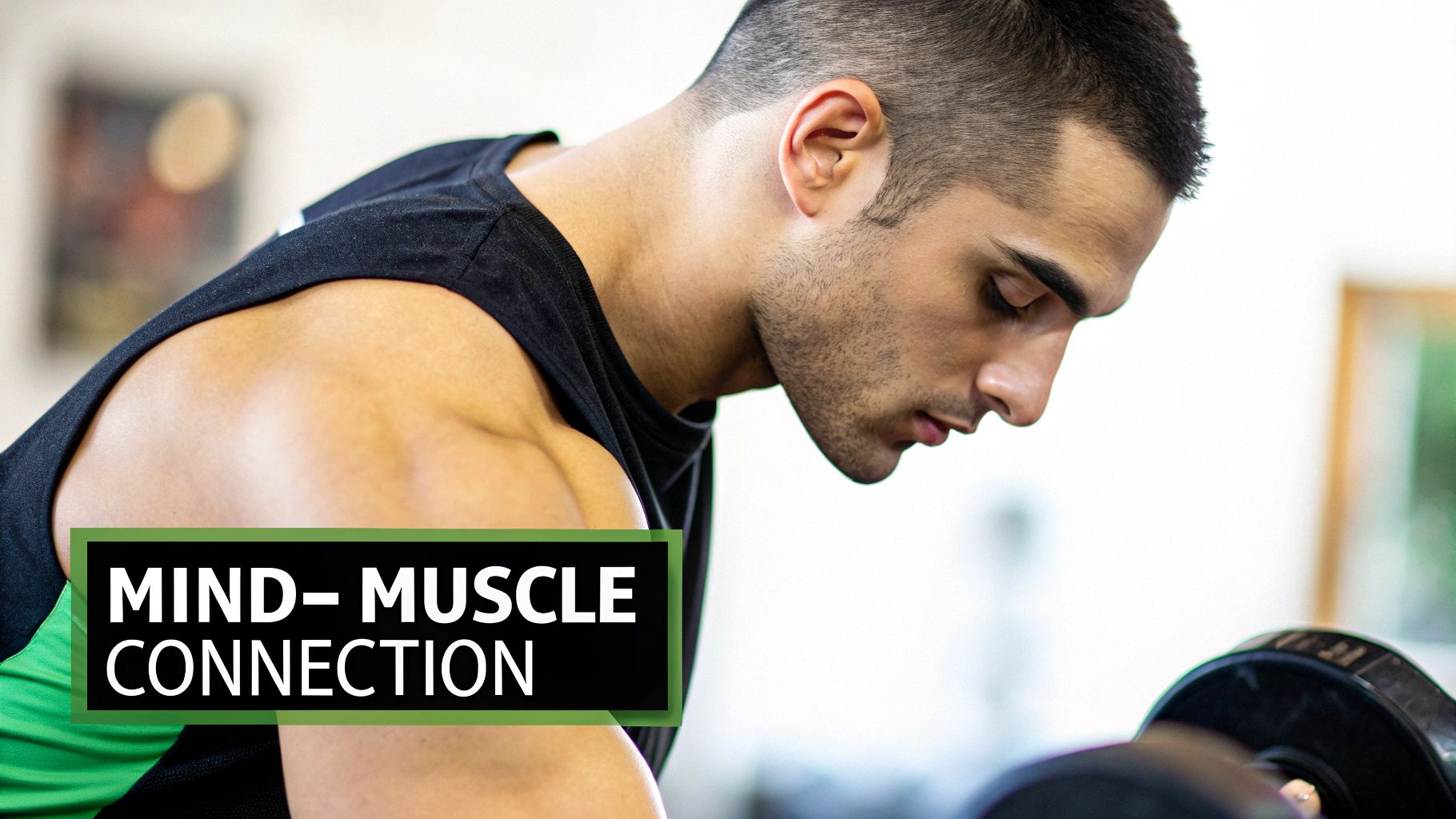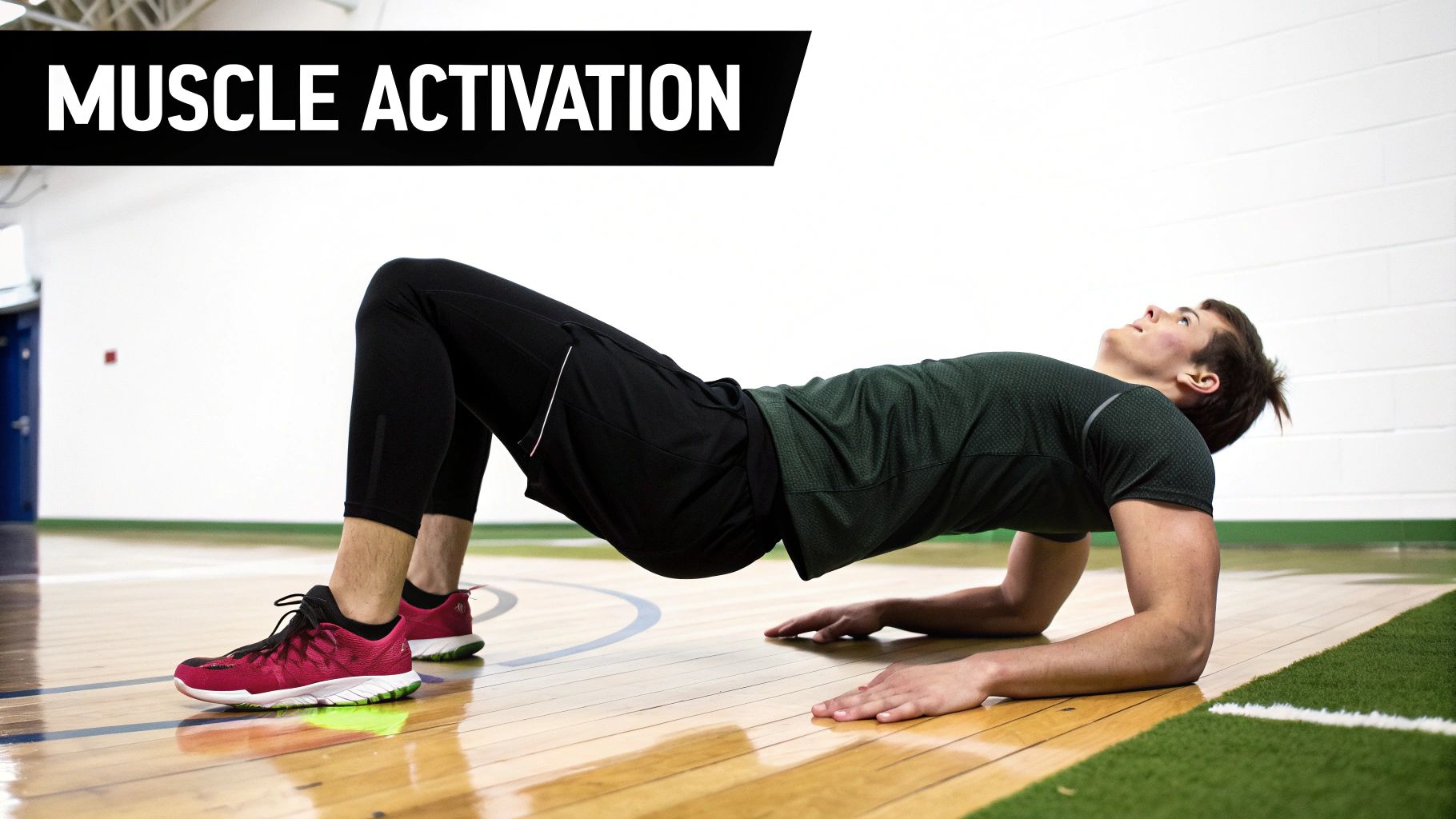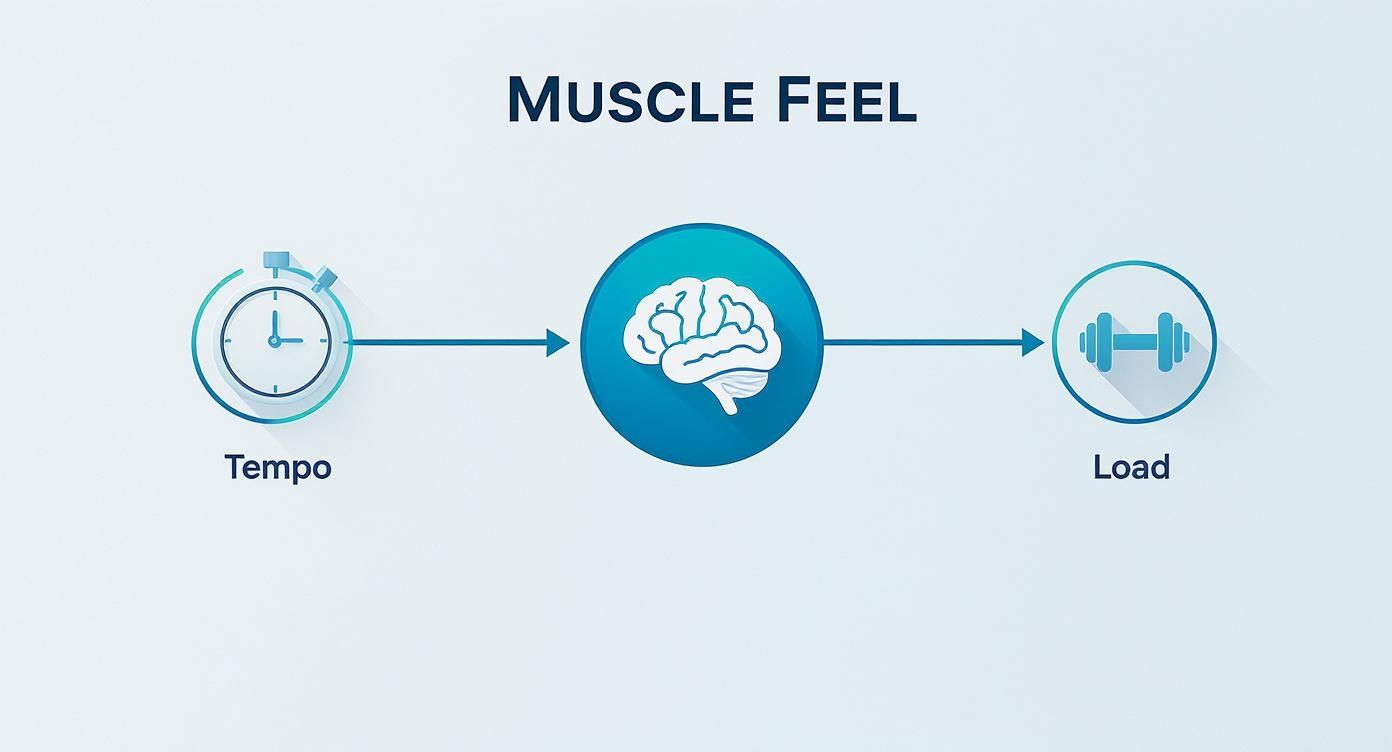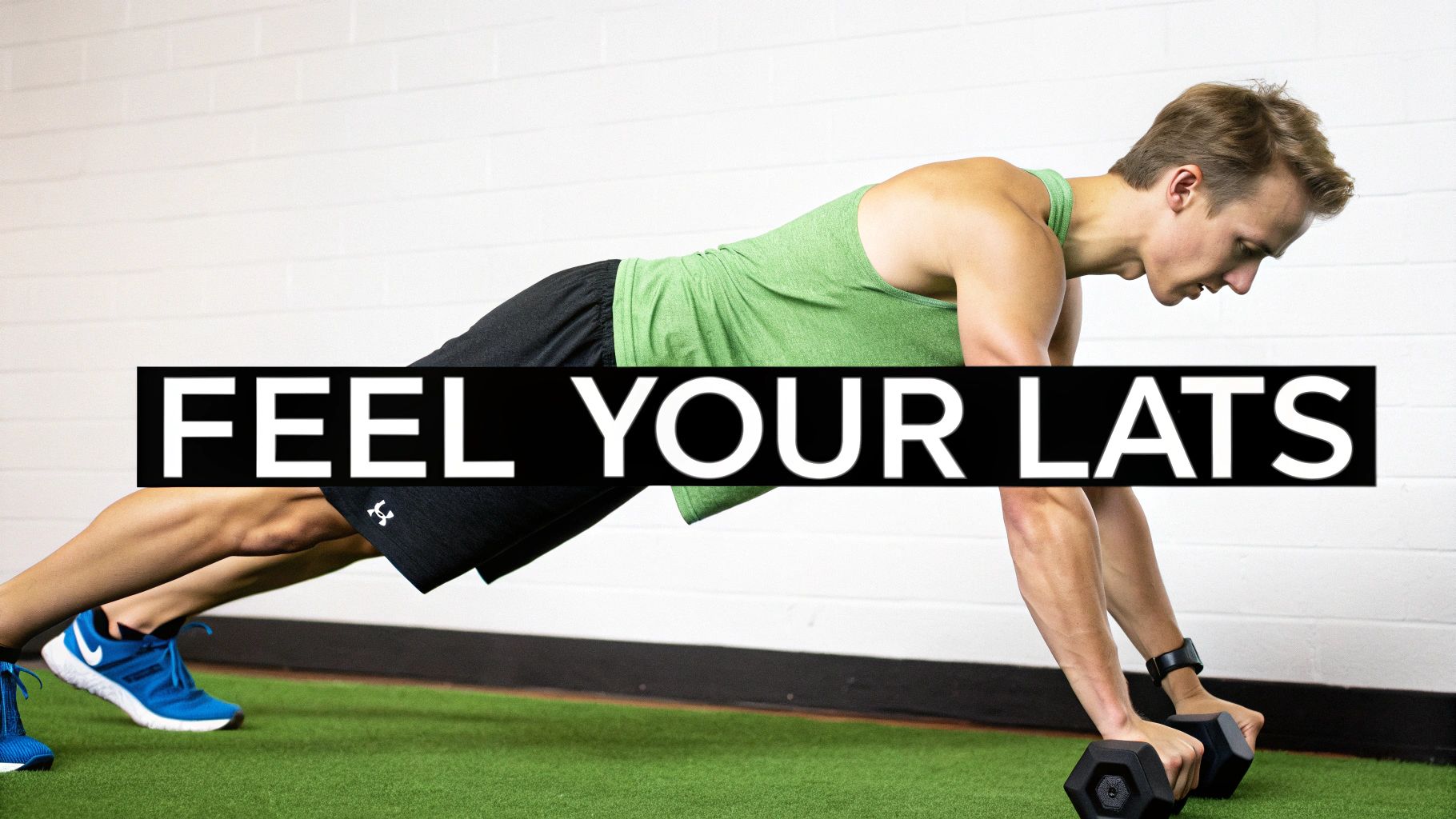
How to improve mind muscle connection: unlock strength
Share
It all comes down to one simple shift: You have to stop moving the weight and start consciously feeling the muscle do the work.
This means slowing down, probably using lighter weights than you're used to, and mentally picturing the exact muscle you're trying to build as it contracts and stretches through every single rep.
What Is the Mind Muscle Connection

Let’s cut through the confusing gym jargon. The mind-muscle connection is your ability to intentionally focus on and feel a specific muscle as you train it. It’s the difference between just getting a weight from point A to point B and feeling every fiber of your glute contract to make that happen.
Think of it as upgrading the communication line between your brain and your glutes. When that signal is weak, your body finds a way to cheat. It recruits stronger, more dominant muscles—like your quads or lower back—to move the weight instead.
This is exactly why you might finish a set of squats feeling a massive burn in your thighs, but almost nothing in your glutes. Your brain just sent the signal to the muscles it knows best.
The Science Behind the Feeling
This isn’t just some fitness trend or "bro science." Deliberately focusing on the muscle you're working has a real, measurable impact on how many muscle fibers you activate. You’re switching your focus from an external goal ("lift this heavy thing") to an internal one ("squeeze this muscle as hard as possible").
This simple mental shift sends a stronger, more precise electrical signal from your brain to that specific muscle, waking up more fibers to join the party.
And the research backs this up. One study found that lifters who concentrated on contracting the target muscle saw a 12.4% increase in muscle thickness over eight weeks. The group that just focused on moving the weight? Only 6.9%. That's a huge difference.
The quality of your workout is determined by the quality of your focus. Simply moving weight is exercise; intentionally contracting a muscle against resistance is training.
This is a non-negotiable principle, especially when you're learning how to build muscle as a woman, because it ensures the right muscles get the signal they need to actually grow.
Before we dive into the specific techniques, let's get clear on the core ideas. These principles are the foundation for everything that follows.
Core Principles of Mind Muscle Connection
| Principle | What It Means | Why It's Important |
|---|---|---|
| Internal vs. External Focus | Focusing on the sensation in the muscle (internal) vs. just moving the weight (external). | An internal focus sends stronger neural signals to the target muscle, activating more fibers. |
| Intentional Contraction | Actively thinking about and initiating the movement by squeezing the target muscle first. | Prevents stronger muscles from taking over and ensures the intended muscle does the work. |
| Tempo and Control | Performing reps slowly and deliberately, especially the eccentric (lowering) phase. | Gives your brain time to "find" the muscle and maintain tension throughout the entire range of motion. |
| Lighter Load Mastery | Using less weight to perfect the feeling of the contraction before adding more resistance. | Heavier weight often forces an external focus ("just survive!"), undermining the connection. |
Mastering these concepts is what separates aimless workouts from targeted, intelligent training.
Why It Matters for Your Goals
Developing this skill is often the missing piece of the puzzle. It’s the difference between just going through the motions and actually sculpting the body you want.
A strong mind-muscle connection helps you:
- Wake up stubborn muscles: Finally feel your glutes, hamstrings, or back muscles fire up properly.
- Improve your form instantly: When you focus on feeling the right muscle, your body naturally adjusts its position to make that happen.
- Make lighter weights feel heavy: You’ll learn how to generate so much internal tension that you don't need back-breaking weight, which seriously lowers your risk of injury.
Start with Activation Drills to Build Your Foundation

Before you can feel your lats fire during a heavy row, you first need to know what that actually feels like. Think of activation drills as your discovery phase—they’re designed to wake up sleepy muscles and build that crucial connection between your brain and your body.
Forget heavy weights for a second. The goal here isn't to build muscle; it's to build awareness. We're starting with simple, low-intensity moves that force you to focus on the unique feeling of a muscle contracting, without the distraction of a heavy load. This is the groundwork for feeling that same contraction under a heavy squat or deadlift.
Isolate to Activate
One of the easiest ways to start is with palpation—literally just touching the muscle you want to work. When you place your hand on a muscle, it gives your brain direct sensory feedback, making that connection feel real and tangible.
For example, a lot of women struggle to isolate their glutes from their hamstrings during hip extensions. Before your next leg day, give this a try:
- Lie on your back with your knees bent and feet flat on the floor, like you’re setting up for a glute bridge.
- Place your hands right on your glutes.
- As you lift your hips, focus only on squeezing the muscles under your fingertips. If you feel your hamstrings cramping up and taking over, lower back down and reset.
That simple act of touching the target muscle helps your brain zero in on exactly where the movement should be coming from.
The point of activation isn’t to get tired; it’s to get connected. You’re teaching your brain a new language, and each gentle squeeze is a new word.
Master the Isometric Hold
Another great technique is the isometric hold, which means you contract a muscle without actually moving. This takes away the complexity of movement and lets you focus purely on creating and holding tension.
Think about a bodyweight squat. Instead of going up and down, just lower yourself into the bottom of the squat and hold it. Now, turn your focus inward. Can you actively squeeze your glutes in that position? Can you feel the tension building in your quads?
Try holding for 15-20 seconds, concentrating only on maintaining that peak squeeze. This teaches you how to keep a muscle "switched on" through an entire set—a critical skill if you want to truly increase your glute size and shape.
Spending just five or ten minutes on these drills primes your body for the real workout. By waking up the right muscles beforehand, you make sure they’re ready to fire when you start adding weight, making every single rep far more effective.
Use Tempo and Load to Feel Your Glutes (Finally)
If there’s one thing killing your mind-muscle connection, it’s ego lifting.
When the number on the dumbbell is your only goal, your body will do whatever it takes to move that weight. It’ll recruit every muscle it can—your lower back, your quads, your hamstrings—instead of isolating the one you’re actually trying to grow.
To fix this, you have to stop asking, "How much can I lift?" and start asking, "How well can I make this muscle work?"
This usually means lifting lighter, but making that lighter weight feel heavy through sheer focus and control.
Slow Down to Speed Up Gains
One of the best ways to force that connection is by playing with tempo—the speed of each rep. Specifically, you want to slow down the eccentric part of the lift (the lowering or stretching phase).
This dramatically increases the time under tension, giving your brain no choice but to stay locked in on the target muscle.
Let's use a hip thrust as an example. Instead of just bouncing the weight up and down, try this:
- Concentric (Lifting): Squeeze your glutes to drive the weight up for 1-2 seconds.
- Peak Contraction: Pause at the very top for 1 full second. Really focus on that intense glute squeeze.
- Eccentric (Lowering): Fight gravity on the way down. Lower the weight slowly over 3-4 seconds, keeping your glutes engaged the entire time.
That deliberate slowdown forces your glutes to do all the work, not momentum. You'll feel a burn you never thought was possible with a weight you used to consider "light."
Find the Right Weight for Connection, Not Ego
Choosing the right load here is a balancing act. It has to be heavy enough to be a challenge, but light enough that your form is perfect and your mind is 100% on the muscle.
If you have to swing, jerk, or use other body parts to move the weight, it's too heavy. Period.
The right weight allows you to feel the target muscle doing 100% of the work, from the first rep to the very last. The moment you lose that feeling, the weight is too heavy.
This isn’t just gym bro-science; it’s backed by research. Studies show that intentionally focusing on a muscle significantly increases its activation, but this trick works best with lighter to moderate weights.
One study found that when people focused on their chest during push-ups, chest activation shot up. But that benefit disappeared once the intensity got to around 80% of their one-rep max. At that point, the body just goes into survival mode to move the heavy load. You can read more about the science behind this on BlenderBottle.com's breakdown of mind-muscle connection.
Think of lighter weights as a teaching tool. You're training your nervous system to fire the right muscles on command. Once you nail that connection, you can start slowly adding weight back—while keeping that same perfect, intentional squeeze.
Master Mental Cues and Visualization Strategies
Once you can feel the muscle, it’s time to level up your mental game. The difference between a good contraction and an incredible, muscle-shaking one often comes down to the specific thoughts, or internal cues, running through your head during a set.
It’s about shifting from a generic goal like "lift the weight" to giving your brain a very specific instruction for the target muscle. For example, on a lat pulldown, just thinking "pull the bar down" often makes your biceps do all the work.
But if you change that one thought to "drive your elbows down into your back pockets," your lats instantly light up. It’s a completely different feeling. That tiny mental switch changes everything.
The Power of Internal Focus
This isn't just bro-science; it’s a proven method for getting stronger and seeing better results.
An 8-week study compared two groups: one was told to focus internally on contracting the muscle, while the other focused externally on just moving the weight. The internal focus group saw a massive 16.2% increase in bicep strength.
The external group? Just 2.6%.
This shows how your mental cues directly fuel your physical gains. If you want a deeper dive, you can explore more about the science of mind-muscle connection and see just how powerful your brain is.
Visualization is like creating a mental blueprint for your muscles. If you can see it happening in your mind's eye, your body is far more likely to follow.
Internal vs. External Cues for Popular Exercises
The trick is swapping out those common, lazy external cues for powerful internal ones that force the right muscle to fire. It’s a subtle but game-changing adjustment.
Here’s a breakdown of how to reframe your thinking on a few classic lifts.
| Exercise | Common (Less Effective) External Cue | Powerful Internal Cue |
|---|---|---|
| Squats/Hip Thrusts | "Stand up" or "Push the bar up" | "Spread the floor apart with your feet" or "Crack a walnut between your cheeks at the top" |
| Shoulder Lateral Raises | "Lift the dumbbells up" | "Push the dumbbells out to the walls on either side of you" |
| Back Rows | "Pull the handle to your body" | "Drive your elbow back as if you're trying to elbow someone behind you" |
See the difference? The internal cues give your muscles a specific job to do, taking the guesswork out of the movement and forcing the right muscle to take over. This is how you make every rep count.
This infographic breaks down how your focus is the missing link between the weight you choose and the tempo you use.

It all comes back to your brain. Your focus is the central element that directs how effective your speed and weight selection will be.
Start by testing one new cue per workout. Pay close attention to the sensation. When you find one that makes the muscle burn in a way it never has before, you've struck gold. This focused, intentional approach is how you improve mind muscle connection and make every single rep more productive.
Target Hard-to-Feel Muscles Like Glutes and Lats

Let’s be real—some muscles are a nightmare to actually feel working. You can do a hundred squats and only feel a burn in your quads, or do rows until your arms give out but your back feels nothing. This is where your mind-muscle connection—or lack of it—is holding you back.
For stubborn muscles like your glutes and lats, just going through the motions is a waste of time. Your body is smart, but it's also lazy. It will always find the easiest way to move the weight, which means letting stronger, more dominant muscles take over.
To fix this, we have to wake up those sleepy muscles before they're even asked to do the heavy lifting.
Start with Pre-Workout Activation
Before you even touch a heavy weight, spend five minutes on targeted activation drills. The goal isn't to get tired; it's to get those muscles "switched on" and ready to fire. Think of it like sending a text to let someone know you're on your way—you're just giving them a heads-up.
For your glutes, try these:
- Glute Bridges: Lie on your back with your knees bent. The only thing you should think about is squeezing your glutes to lift your hips off the floor. Hold it at the top for a two-second count and feel that intense squeeze.
- Banded Clamshells: Put a resistance band around your thighs and lie on your side. Keep your feet stacked and lift your top knee, using only your outer glute to drive the movement.
And for your lats:
- Band Pull-Aparts: Grab a light resistance band. With your arms straight out in front of you, pull the band apart by squeezing your shoulder blades together. Imagine you’re trying to pinch a pencil right between them.
These simple moves prime the connection between your brain and the muscle, making it way easier to feel them working during your main lifts.
Fine-Tune Your Form and Focus
During your actual workout, small tweaks in your form and where you put your mental focus can change everything. It’s not just about what you do, but how you think about doing it.
Take the classic barbell squat. If your quads are always taking over, the problem is probably how you're initiating the movement. Instead of just thinking "stand up," focus on your feet. Try to "screw your feet into the floor"—this creates external rotation in your hips and immediately engages your glutes. As you stand up, think about pushing the floor away through your heels.
The most powerful tool for muscle activation isn't the weight you're holding; it's the specific thought in your head. A simple change in your internal cue can instantly redirect tension from a dominant muscle to the one you actually want to grow.
It's the same idea for rows. If your arms are doing all the work, stop thinking about pulling the handle with your hands. Instead, think of your hands as simple hooks. Start the movement by driving your elbows back and squeezing your shoulder blades together. This mental shift forces your lats to take over as the primary movers.
For more in-depth strategies to get your glutes firing, check out our complete guide on how to grow your glutes.
By pairing pre-workout activation with these small but powerful form adjustments, you can finally feel those stubborn muscles contracting on every single rep. That’s the real secret to unlocking new growth and building a more balanced, sculpted body.
Frequently Asked Questions
Once you start focusing on the mind-muscle connection, questions always come up. It's a huge shift from just moving weight, so it's normal to wonder if you're doing it right. Let's clear up a few things so you can get back to training with confidence.
Does the Mind-Muscle Connection Work for Every Exercise?
This technique is a game-changer for exercises aimed at hypertrophy—the fancy term for building muscle size. It’s perfect for isolation moves like bicep curls and most compound lifts like squats or rows, where the goal is to feel the muscle doing the work.
But it’s not for everything.
When you’re going for a max-effort lift—like a one-rep max squat or a heavy clean and jerk—an external focus is your friend. Thinking "drive the floor away" will help you move more weight than thinking "squeeze my glutes." For building and sculpting, though, that internal focus is almost always the way to go.
Will I Have to Lift Light Forever?
Not at all. This is the biggest myth out there.
Lifting light isn't the end goal; it's a teaching tool. You drop the weight to build the skill and actually learn what a good contraction feels like without your ego taking over.
Once that connection is solid, you start adding weight back on—slowly. The goal is progressive overload, but only if you can keep that same intense focus.
Here’s the rule: if adding weight makes you lose the feeling in the target muscle, you went too heavy, too fast. Drop it back down. It’s a constant balance between pushing your muscles and keeping your mind locked in.
It’s like learning an instrument. You don’t jump straight to a complex solo. You start with slow, simple scales until your fingers know exactly what to do.
How Long Does It Take to Develop This Connection?
It depends on the person and the muscle. This is a skill, and like any other skill, it takes patience.
You might feel your biceps firing on day one—you can literally see them working in the mirror, after all.
But feeling your lats or deep glutes? That could take weeks of focused, consistent practice. These muscles are harder to see, and most of us have spent years ignoring them, so the neural pathways are weak.
Celebrate the small wins. That first time you finally feel your glutes burn during a hip thrust is a massive breakthrough. Consistency beats intensity here. Stick with the activation drills and controlled reps, and that connection will get stronger with every workout. Be patient and trust the process.
Ready to give your glutes the fuel they need to grow? Bold Buns is designed to support your training, helping you get more out of every focused rep. Our creatine formula is made for women who want to build strength and sculpt their bodies. Check out Bold Buns and start building with confidence.
